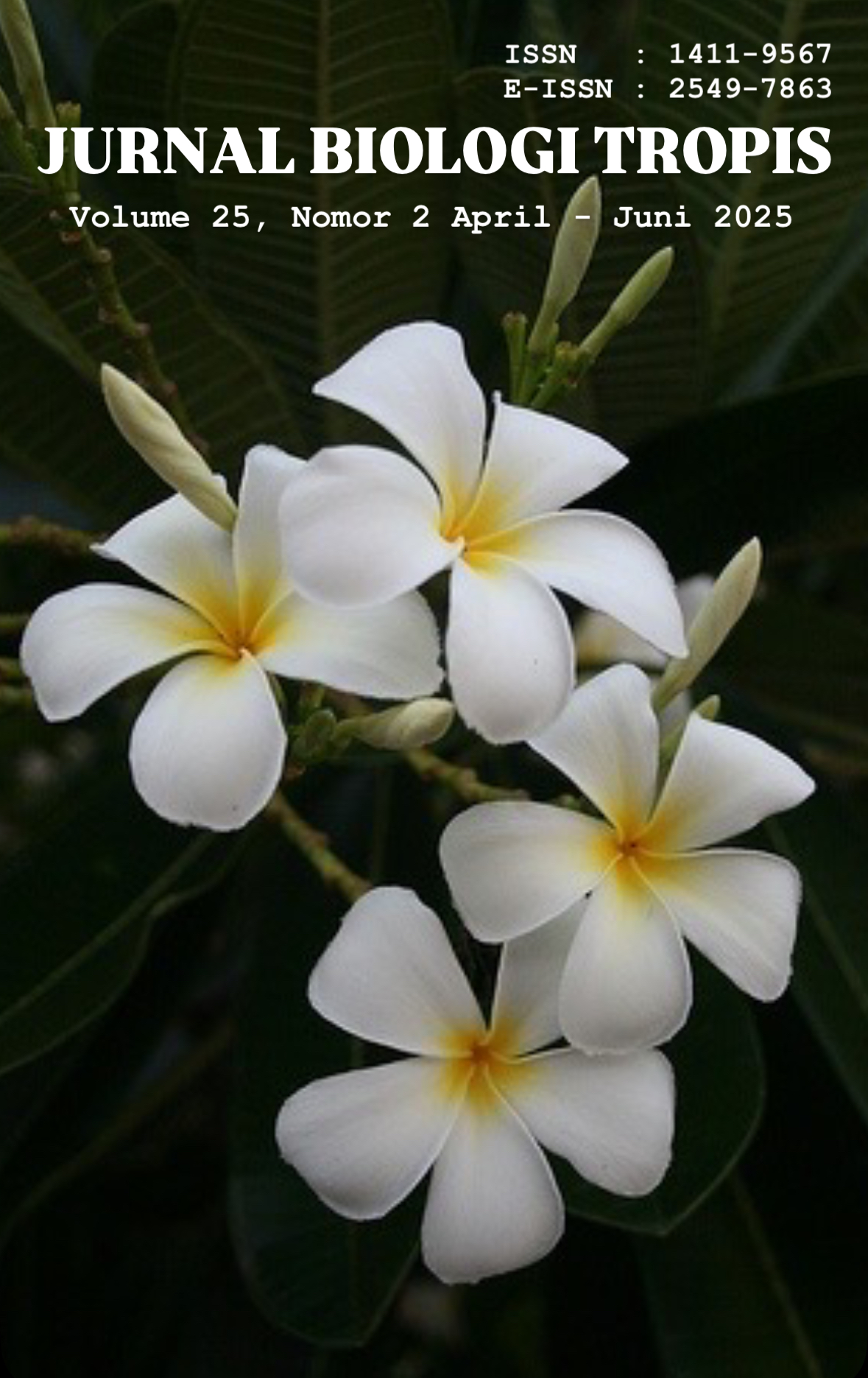Genetic Variation Analysis of L1 gene HPV-16 using RFLP in Silico
Authors
Santi Afionita , Dwi Hilda Putri , Afifatul Achyar , Elsa YuniartiDOI:
10.29303/jbt.v25i2.8415Published:
2025-04-23Issue:
Vol. 25 No. 2 (2025): April-JuniKeywords:
Genetic variation, HPV, in silico, L1 gene, RFLP.Articles
Downloads
How to Cite
Downloads
Metrics
Abstract
Human papillomavirus (HPV) is one of the leading causes of cervical cancer, with the L1 gene playing an important role in vaccine development. This study aims to analyze the genetic variation of the L1 gene of HPV types 16, 18, 52, and 58 using the RFLP method in silico by utilizing restriction enzymes. The results showed that. The pattern of genetic conservation is more dominant in HPV 16 and 52 than other types, indicating the potential important role of the L1 gene in vaccine development. This study confirms the importance of analyzing genetic variation to understand HPV genetic diversity. These results may contribute to the development of more specific vaccines and molecular markers for HPV detection.
References
Achyar A, Hindayageni A, Humaira F, Wijaya NN, Aqsha N, Zultsatunni’mah Z. (2021). “Analysis of Genetic Variations in Poly Gene Sequences in Dengue Virus 2 Using In-Silico RFLP,” Bioscience, vol. 5, no. 1, pp. 80–86, 2021, Doi: 10.24036/0202151111916-0-00.
Andre, P. R. (2019). Analisis Variasi Genetik Gen L1 Hpv Tipe 16 Asal Sumatera Barat Dan Translasi Protein Gen L1 Hpv 16 Secara in Silico (Doctoral Dissertation, Universitas Andalas).
Baker, T. S., Newcomb, W. W., Olson, N. H., Cowsert, L. M., Olson, C., & Brown, J. C. (1991). Structures of bovine and human papillomaviruses. Analysis by cryoelectron microscopy and three-dimensional image reconstruction. Biophysical journal, 60(6), 1445–1456. Doi: 10.1016/S0006-3495(91)82181-6.
Chenna, R., Sugawara, H., Koike, T., Lopez, R., Gibson, T. J., Higgins, D. G., & Thompson, J. D. (2003). Multiple sequence alignment with the Clustal series of programs. Nucleic acids research, 31(13), 3497-3500. DOI: 10.1093/nar/gkg500.
Dai, S., & Long, Y. (2015). Genotyping analysis using an RFLP assay. Plant Genotyping: Methods and Protocols, 91-99. DOI: 10.1007/978-1-4939-1966-6_7
Densi, S. S. (2016). Analisa Variasi Molekuler Gen E5 Human Papillomavirus (Hpv Dari Isolat Penderita Kanker Serviks (Doctoral Dissertation, Universitas Andalas).
Dunne, E. F., & Park, I. U. (2013). HPV and HPV-associated diseases. Infectious disease clinics of North America, 27(4), 765–778. Doi: 10.1016/j.idc.2013.09.001.
Erni, E., & Wathon, S. (2019). Pengembangan sistem deteksi hpv (Human Papilloma Virus) berbasis marka molekuler pcr-rflp. Biotrends, 9(2), 48-55.
Fadhilah, F. R., Sahiratmadja, E. K., Safitri, R., Maskoen, A. M., & Susanto, H. (2015). Analisis filogenetik gen L1 human papillomavirus 16 pada penderita kanker serviks di Bandung. Majalah Kedokteran Bandung, 47(3), 174–178. DOI: 10.15395/mkb.v47n3.598
Gumilar, G. G., & Susanti, E. S. (2021). Variasi Mutasi Daerah HVI DNA Mitokondria Suku Bima-Dompu Nusa Tenggara Barat. Chemica Isola, 1(1), 31-36. Doi: 10.17509/ci.v1i1.33180
Kayser, F. H., Bienz, K. A., Eckert, J., & Zinkernagel, R. M. (2005). Medical Microbiology, Thieme Stuttgart.
Krakauer, E. L., Kwete, X., Kane, K., Afshan, G., Bazzett-Matabele, L., Bien-Aimé, D. D. R., ... & Fidarova, E. (2021). Cervical cancer-associated suffering: estimating the palliative care needs of a highly vulnerable population. JCO global oncology, 7, 862-872. Doi: 10.1200/GO.21.00025.
Lipinwati. (2014). Diagnosis Molekuler Human Papillomavirus (HPV) penyebab Kanker Serviks. Jambi Medical Journal, 2(1), 78-86. Doi: 10.22437/jmj.v2i1.2701.
Mahasri, G., Wilujeng, L., & Mufasirin, M. (2014). Keragaman Gen Cytochrome B pada Sidat (Anguila bicolor) Berdasarkan Restriction Fragment Length Polymorphism (RFLP). Jurnal Ilmiah Perikanan Dan Kelautan, 6(2), 117–124.Doi: 10.20473/jipk.v6i2.11294
Medeiros, R., Vaz, S. S. G., Rebelo, T., & Figueiredo Dias, M. (2020). Prevention of human papillomavirus infection. Beyond cervical cancer: a brief review. Acta medica portuguesa, 33(3), 198-201. Doi: 10.20344/amp.12259.
Mirabello, L., Yeager, M., Cullen, M., Boland, J. F., Chen, Z., Wentzensen, N., ... & Schiffman, M. (2016). HPV16 sublineage associations with histology-specific cancer risk using HPV whole-genome sequences in 3200 women. JNCI: Journal of the National Cancer Institute, 108(9), djw100. Doi: 10.1093/jnci/djw100.
Nabilla, M. (2024). Analisis Jurnal Variasi Genetik Makhluk Hidup Eukariotik. Jurnal Multidisiplin Ilmu Akademik, 1(3), 861-871. Doi: 10.61722/jmia.v1i3.1798.
Nawangsih, A. A. (2023). Keanekaragaman Karakter Galur-Galur Bakteri Penyebab Busuk Hitam (Xanthomonas campestris pv. campestris) pada Kubis terhadap Campuran Bahan Aktif Azoksistrobin dan Difenokonazol. Jurnal Fitopatologi Indonesia, 19(2). Doi: 10.14692/jfi.19.2.45-56.
Nugraha, F., Roslim, D. I., & Ardilla, Y. P. (2014). Analisis sebagian sekuen gen Ferritin2 pada padi (Oryza sativa L.) Indragiri Hilir, Riau. Biosaintifika: Journal of Biology & Biology Education, 6(2), 70-79. Doi: 10.15294/biosaintifika.v6i2.3102.
Pradita, A., Sahiratmadja, E., Suhandono, S., & Susanto, H. (2014). Sekuens gen protein kapsid mayor L1 human papilomavirus 16 dari isolat klinik asal Bandung. Majalah Kedokteran Bandung, 46(3), 143-149. Doi: 10.15395/mkb.v46n3.317
Rader, J. S., Tsaih, S. W., Fullin, D., Murray, M. W., Iden, M., Zimmermann, M. T., & Flister, M. J. (2019). Genetic variations in human papillomavirus and cervical cancer outcomes. International journal of cancer, 144(9), 2206–2214. Doi: 10.1002/ijc.32038.
Rani, W. M., Puspita, R. D., Sefina, N., Sa’adah, N., & Achyar, A. (2024). Analisis Variasi Genetik Gen L1 HPV-52 Menggunakan RFLP secara in Silico. Indonesian Journal of Pharmaceutical Education, 4(1). Doi: 10.37311/ijpe.v4i1.24496.
Safitri, T. A., Patty, D. N. J., & Saraswati, H. (2018). Gen L1 HPV 16 dan 18 sebagai dasar dalam desain primer untuk deteksi kanker leher rahim dengan in-house. Indonesian Journal of Biotechnology and Biodiversity, 2(2), 67–71. Doi: 10.47007/ijobb.v2i2.5.
Schurr, T. G. (2000). Mitochondrial DNA and the Peopling of the New World. American scientist, 88(3), 246-253.
Steenbergen, M., de Wilde, J., Wilting, S. M., Brink, A. A. T. P., Snijders, P. J., & Meijer, C. J. L. M. (2005). Human papillomavirus-mediated transformation of the anogenital tract. Journal of Clinical Virology, 325, 525–533. Doi: 10.1016/j.jcv.2004.11.019.
Sung, H., Ferlay, J., Siegel, R. L., Laversanne, M., Soerjomataram, I., Jemal, A., & Bray, F. (2021). Global Cancer Statistics 2020: GLOBOCAN Estimates of Incidence and Mortality Worldwide for 36 Cancers in 185 Countries. CA: a cancer journal for clinicians, 71(3), 209–249. 10.3322/caac.21660.
Tsakogiannis, D., Nikolaidis, M., Zagouri, F., Zografos, E., Kottaridi, C., Kyriakopoulou, Z., Tzioga, L., Markoulatos, P., Amoutzias, G. D., & Bletsa, G. (2022). Mutation Profile of HPV16 L1 and L2 Genes in Different Geographic Areas. Viruses, 15(1), 141. Doi: 10.3390/v15010141.
Wang, L., Wang, F., Fu, S., Zhang, C., Zhe, X., Li, H., Li, D., Shao, R., & Pan, Z. (2021). Analysis of genetic variation in human papillomavirus type 16 E1 and E2 in women with cervical infection in Xinjiang, China. BMC medical genomics, 14(1), 268. Doi: 10.1186/s12920-021-01120-9.
Wei, W., Davis, R. E., Lee, I. M., & Zhao, Y. (2007). Computer-simulated RFLP analysis of 16S rRNA genes: identification of ten new phytoplasma groups. International journal of systematic and evolutionary microbiology, 57(8), 1855-1867.
WHO (2022) Human Papillomavirus vaccines: WHO position paper.
Yugawa, T., & Kiyono, T. (2009). Molecular mechanisms of cervical carcinogenesis by high‐risk human papillomaviruses: novel functions of E6 and E7 oncoproteins. Reviews in medical virology, 19(2), 97-113. Doi: 10.1002/rmv.605.
License
Copyright (c) 2025 Santi Afionita, Dwi Hilda Putri, Afifatul Achyar, Elsa Yuniarti

This work is licensed under a Creative Commons Attribution 4.0 International License.

Jurnal Biologi Tropis is licensed under a Creative Commons Attribution 4.0 International License.
The copyright of the received article shall be assigned to the author as the owner of the paper. The intended copyright includes the right to publish the article in various forms (including reprints). The journal maintains the publishing rights to the published articles.
Authors are permitted to disseminate published articles by sharing the link/DOI of the article at the journal. Authors are allowed to use their articles for any legal purposes deemed necessary without written permission from the journal with an acknowledgment of initial publication to this journal.


























